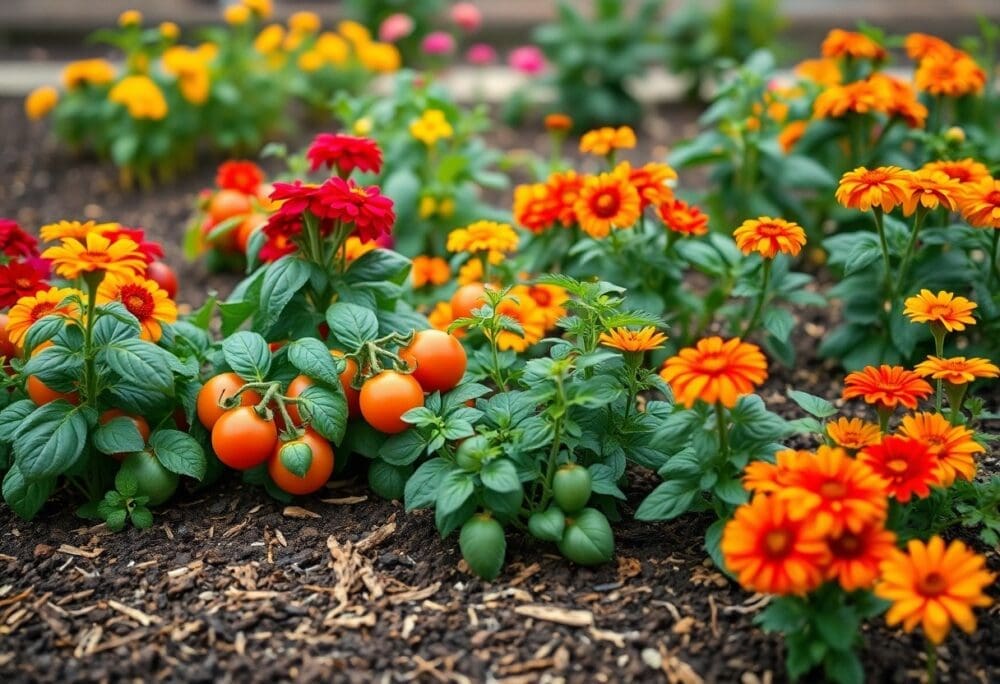Over the years, companion planting has emerged as a vital technique for promoting sustainable gardening. By strategically pairing plants that benefit each other, you can enhance growth, deter pests, and improve soil health—all while making the most of your garden space. In this guide, you will discover effective combinations and the science behind them, empowering you to cultivate a thriving ecosystem right in your backyard. Embrace these practices to not only elevate your gardening game but also contribute to a healthier environment.
Key Takeaways:
- Companion planting can enhance plant growth, deter pests, and improve soil health by strategically pairing compatible plants.
- Understanding the relationships between different species, such as which plants repel pests or enhance nutrient availability, is vital for successful implementation.
- Utilizing native plants and biodiversity within companion planting fosters a more resilient and sustainable garden ecosystem.
Types of Companion Plants
To successfully implement companion planting in your garden, it’s important to understand the types of plants that synergize well together. Different plants exhibit unique benefits when paired, which can improve growth and yield. Here’s a breakdown of common types of companion plants:
| Type | Benefits |
|---|---|
| Vegetables | Enhance growth and deter pests. |
| Herbs | Repel pests and attract beneficial insects. |
| Flowers | Attract pollinators and repel harmful insects. |
| Fruits | Support growth and improve flavor. |
| Cover Crops | Improve soil health and prevent erosion. |
Recognizing the benefits of these plant types can lead to a more productive and resilient garden.
Vegetables
Some of the most effective companion vegetables include tomatoes paired with basil or carrots alongside onions. These combinations can enhance growth, improve pest resistance, and encourage yield. As you plan your garden, consider these beneficial pairings to maximize the productivity of your vegetable patch.
Herbs
One excellent way to boost your garden’s health is by integrating herbs, such as rosemary or mint, alongside your crops. These plants can serve multiple purposes; they not only enhance the flavor of your dishes but also act as natural pest deterrents. Furthermore, herbs like dill can attract predatory insects, providing a natural form of pest control.
Herbs contribute significantly to a sustainable gardening approach by enhancing biodiversity. By diversifying your garden with aromatic herbs, you can create an ecosystem that supports beneficial insects and improves the health of surrounding plants. This synergy of scents and flavors plays a vital role in fostering a more resilient garden environment.
Flowers
To enrich your garden further, consider planting flowers such as marigolds alongside your vegetables. These blooming beauties not only add visual appeal but also serve important functions, like attracting pollinators and repelling pests. A colorful assortment of flowers can elevate the entire garden experience while increasing biodiversity.
As you incorporate flowers, remember that certain varieties can act as trap crops, luring harmful insects away from your more vulnerable plants. By strategically placing flowering plants throughout your garden, you can create a balanced ecosystem that encourages beneficial wildlife, resulting in a flourishing and sustainable garden.
Benefits of Companion Planting
It is imperative to understand the numerous advantages of companion planting, as it not only enhances your garden’s health but also promotes a sustainable approach to gardening. This practice can lead to improved pest management, enhanced soil health, and increased yields, making your gardening experience both fruitful and environmentally friendly.
Pest Control
Some plants can effectively deter pests from neighboring plants, creating a natural form of pest control. By strategically pairing certain species, you can reduce the need for chemical pesticides, which benefits both your plants and the surrounding ecosystem.
Soil Health
Soil health is paramount for thriving plants, and companion planting can significantly boost the nutrient composition of your soil. By selecting complementary plants, you can enhance nutrient uptake and promote a healthy microbial community.
This method often involves planting legumes, which naturally fix nitrogen in the soil, alongside heavy feeders like tomatoes or corn. As these diverse plants grow together, they create an ecosystem that supports each other’s needs, ultimately resulting in fertile soil that enhances growth and resilience in your garden.
Increased Yield
While you might think that spacing out plants is the best way to cultivate a bountiful garden, companion planting demonstrates that close-knit relationships can greatly boost your harvest. This synergy allows plants to share resources, leading to an efficient use of space and nutrients.
For instance, planting basil near tomatoes can improve tomato growth and flavor while keeping pests at bay. Similarly, intercropping carrots with onions can minimize pest issues while maximizing the use of your garden area, resulting in a more abundant and diverse harvest.
Factors to Consider in Companion Planting
After determining which plants to grow together, consider several factors that influence successful companion planting. Key points to take into account include:
- Plant Compatibility
- Growth Habits
- Climate and Soil Conditions
Thou must ensure that all elements work harmoniously for the best results.
Plant Compatibility
Compatibility is vital in companion planting. Some plants naturally support each other, improving growth, flavor, or pest resistance, while others may compete for nutrients or space, leading to poor outcomes. Understanding which plants thrive together is vital for your garden’s health.
Growth Habits
For a successful garden, you need to consider the growth habits of the plants you choose. Different plants have varying heights, root structures, and growth rates, which can positively or negatively affect their companions.
For instance, tall plants like sunflowers can provide shade for smaller plants such as lettuce, helping them thrive in warmer conditions. Conversely, fast-growing plants may outcompete slower ones for light and nutrients, hindering their development. Keeping these habits in mind fosters a more balanced and productive garden.
Climate and Soil Conditions
Consider your local climate and soil conditions when selecting companions. Different plants have specific requirements for temperature, humidity, and soil type, which significantly impact their growth and compatibility.
Growth of any garden relies on matching plants to your environmental conditions. For example, if you live in a humid region, consider pairing moisture-loving plants together. Likewise, ensure that your soil is well-suited for the needs of the various plants to nourish them effectively and help them thrive.
Step-by-Step Guide to Companion Planting
Unlike traditional gardening methods, companion planting emphasizes the balance of plant relationships to optimize growth and pest management. By following this step-by-step guide, you can create a harmonious garden that nurtures both your plants and the environment. Below is a quick reference of key considerations:
| Consideration | Description |
|---|---|
| Plant Selection | Choose compatible plants that benefit each other. |
| Layering | Utilize vertical space by planting taller crops alongside shorter ones. |
| Succession Planting | Time your planting schedule for continuous growth. |
Planning Your Garden
One effective way to begin companion planting is by creating a garden plan that includes your chosen plants and their companions. Consider factors such as the sunlight needs, growth habits, and pest profiles of each plant to ensure that they support each other’s development.
Planting Techniques
If you want to maximize your garden’s potential, implement specific planting techniques for companion planting. This includes grouping compatible plants together to encourage growth, repel pests, and enhance nutrient uptake.
To achieve the best results, consider using intercropping, which allows you to plant two or more compatible species close together. This increases biodiversity and helps reduce weeds, pests, and disease. Additionally, utilizing natural structures, such as trellises or fences, can offer support for climbing plants, creating more efficient use of space in your garden.
Maintenance Tips
Some imperative maintenance tips can help you maintain a thriving companion planting garden. Routinely check for signs of pests and diseases, and make adjustments to your plant groupings as needed. Here are practical tips to consider:
- Regularly monitor soil health and moisture levels.
- Rotate crops each season to maintain soil fertility.
- Incorporate organic matter, like compost, for nutrient enhancement.
Perceiving the interconnectedness of your plant relationships will further enhance your success in sustainable gardening.
Planning your maintenance is just as vital as initial planting. Keeping a routine can help you track your plants’ health, address pest problems quickly, and ensure that your companion plants continue to support each other effectively. Incorporate these tips into your garden practice:
- Implement companion flowers to attract beneficial insects.
- Use mulch to conserve moisture and suppress weeds.
- Maintain good airflow among plants to prevent diseases.
Perceiving these details will elevate your gardening experience.
Tips for Successful Companion Planting
All successful companion planting practices begin with a few key strategies to enhance plant synergy in your garden. To make the most of your planting efforts, consider the following tips:
- Research compatible plant combinations.
- Plan your layout carefully to maximize benefits.
- Maintain soil health for better plant performance.
- Use natural pest deterrents as companions.
- Keep a gardening journal to track results.
Recognizing the signs of success and potential challenges will help you refine your gardening techniques over time.
Crop Rotation
Planting diverse crops in a planned sequence each season helps maintain soil fertility and disrupt pest cycles. By rotating your crops, you reduce the risk of soil-borne diseases and nutrient depletion. Furthermore, this practice ensures that your garden remains productive, giving each plant type the best conditions to thrive.
Seasonal Considerations
Companion planting is not just about what grows well together but also about aligning your planting schedules with seasonal changes. Each plant has its growth cycle, and understanding when to sow, transplant, or harvest is necessary to maximize your garden’s yield. Timing your planting based on seasonal factors will ensure your plants are properly established before challenging weather conditions.
With careful planning around seasonal changes, your garden can flourish. Different plants have varied needs for sunlight, warmth, and moisture, so tailor your selections to align with the prevailing conditions. Pay close attention to the local climate, and consider selecting faster-growing varieties to fill gaps during slower seasons. Adapting your planting schedule ensures that all plants receive the best possible growing conditions, enhancing both productivity and resilience in your garden.
Observation and Adjustments
Rotation is key to a successful companion planting strategy. Regularly observe your plants and their interactions. Take note of how they affect each other, which combinations flourish, and which may struggle. This attentiveness will guide you in making necessary adjustments, whether that involves changing plant placements or modifying care approaches.
Understanding your garden ecosystem is vital for ongoing improvements. Embrace the process of reflection after each growing season; this involves analyzing what worked and what could be improved. Keeping detailed notes can help you identify patterns and trends, allowing you to cultivate a more successful and sustainable companion planting experience over time.
Pros and Cons of Companion Planting
For those exploring the effectiveness of companion planting, weighing the pros and cons is vital for making informed gardening choices. Below is a summary of advantages and challenges to consider:
Pros and Cons of Companion Planting
| Pros | Cons |
|---|---|
| Enhances plant growth | Requires research on pairings |
| Deters pests naturally | Limited space availability |
| Improves soil health | May increase competition for nutrients |
| Encourages biodiversity | Less effective in poor soil conditions |
| User-friendly for organic gardening | Time-consuming planning |
For more insights, check out this Organic Vegetable Gardening Companion Planting resource.
Advantages
One of the primary advantages of companion planting is its ability to promote healthier plants. By strategically pairing compatible species, you can naturally repel pests, enhance nutrient absorption, and improve overall growth rates. This holistic approach not only supports sustainable gardening practices but also helps create a vibrant ecosystem in your garden.
Potential Challenges
Pros of companion planting include challenges related to plant compatibility. Misunderstanding which plants work well together can lead to ineffective arrangements, potentially harming your garden’s yield. Additionally, factors such as space constraints may limit your ability to implement certain combinations.
For instance, careful planning is required to avoid overcompeting plants that may deplete soil nutrients or hinder growth. It’s also necessary to conduct thorough research on the specific needs of each plant, as factors like sunlight and water requirements can vary significantly within different species. This may lead to time constraints as you fine-tune your companion planting strategy.
Final Words
So, as you explore the world of companion planting, you can enhance your garden’s health, improve pest management, and promote biodiversity. By pairing specific plants thoughtfully, you can create a thriving ecosystem that nurtures your crops and improves your gardening experience. Embrace the techniques and principles outlined in this guide to cultivate a flourishing, sustainable garden that reflects your commitment to the environment.
FAQ
Q: What is companion planting and how does it benefit my garden?
A: Companion planting involves growing different plants together for mutual benefits such as pest control, pollination enhancement, and improved growth. By strategically pairing plants, gardeners can create a more balanced ecosystem in their gardens, which can reduce the need for chemical pesticides, promote biodiversity, and enhance soil health. Examples include planting marigolds alongside tomatoes to deter harmful pests or using corn to support climbing beans.
Q: Are there specific plants that work well together for companion planting?
A: Yes, certain plants are known to thrive when grown in proximity to each other. For example, basil and tomatoes make an excellent pair, as basil can repel pests that typically target tomatoes while enhancing their flavor. Similarly, carrots and onions can benefit each other; the scent of onions can help to deter pests that target carrots. Researching and pairing plants with complementary needs and characteristics is key to successful companion planting.
Q: How can I implement companion planting in my garden without overwhelming myself?
A: To start with companion planting, consider focusing on a few key plant pairs rather than trying to incorporate many at once. Begin by selecting plants that you already enjoy growing and find a couple of companion plants for each. Keep it simple by planting in small sections of your garden or in containers. Additionally, documenting your observations can help you learn which combinations work best, making future planting easier and more effective.





